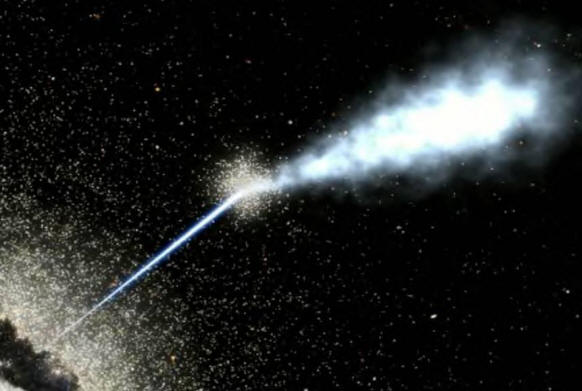
home •
about •
essential guide •
picture of the day •
thunderblogs •
news •
multimedia •
predictions •
products •
get involved •
contact
picture of the day archive subject index
Artist’s rendition of galactic system 3C321 X-ray jet deflection.
Credit: NASA/STScI/G. Bacon
Sep 02, 2008
Galactic Deflection
Combined observations seem to indicate an active jet of high-velocity particles deflected from the edge of another galaxy. Could electrical interaction be the cause?NASA recently announced the discovery of two galaxies orbiting a common center but with a twist: the larger of the two is firing a jet of energetic material out of a black hole directly at the edge of its smaller neighbor.
“We've seen many jets produced by black holes, but this is the first time we've seen one punch into another galaxy like we're seeing here." said Dan Evans, a scientist at the Harvard-Smithsonian Center for Astrophysics.
According to conventional astronomical theories, jets from massive black holes (said to reside in the center of most galaxies) emit copious amounts of radiation, especially X-rays and gamma rays. These extremely energetic electromagnetic waves travel at the speed of light, transporting energy far from the black holes and initiating effects on large-scale environments. The 3C321 phenomenon represents the first time a “jet” has been observed to “impact” another galaxy.
Learning more about jets is a key goal for astrophysical research. "We see jets all over the Universe, but we're still struggling to understand some of their basic properties," said co-investigator Martin Hardcastle of the University of Hertfordshire, United Kingdom. "This system of 3C321 gives us a chance to learn how they're affected when they slam into something - like a galaxy - and what they do after that."
In conventional galactic models, there is no “edge” to a disc of stars revolving around their common center. The stars are loosely bound together by the force of gravity and are more like a swarm of bees than like a solid object. In that sense, the stellar swarm would not deflect a stream of hot gas and dust; it would be absorbed and diffused throughout the structure. So it must be asked, off what are the high-energy particles bouncing?
In the Electric Universe model of stars and galaxies the cosmos is a manifestation of plasma in its multi-various forms. There is no neutral matter in the universe – no conglomerations of smoky gas, no wisps of unionized dust – everything is electrically active and behaves as a plasma should behave.
Pioneering researcher Hannes Alfvén found that stars (and galaxies) are part of electrical circuits and are influenced by the magnetic fields that are generated by them. In the presence of electric currents, gravity gives way to electromagnetic forces that are incomparably more powerful, accelerating matter away from a star or a collection of stars. It is through that mechanism that “jets” of matter are fired from the poles of stars or from the active galaxies.
Plasma physicists have experimentally confirmed that a toroidal magnetic field confines an electric discharge. The magnetic field keeps the charged particles from dispersing. Similarly, magnetism and electric circuits within galaxies hold the stars together, magnetically, so its neighbor may electromagnetically repel the jet from the larger galaxy in 3C321.
By Stephen Smith
___________________________________________________________________________Please visit our Forum
The Electric Sky and The Electric Universe available now!

|
|

|
EXECUTIVE EDITORS:
David Talbott, Wallace Thornhill
MANAGING EDITORS:
Steve Smith, Mel Acheson
CONTRIBUTING EDITORS: Michael Armstrong, Dwardu Cardona,
Ev Cochrane,
C.J. Ransom, Don Scott, Rens van der Sluijs, Ian Tresman
WEBMASTER: Brian Talbott
Copyright 2007: thunderbolts.info
![]()
home •
thunderblogs •
forum •
picture of the day •
resources •
team •
updates •
contact us

